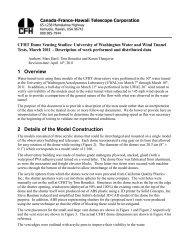ALLEN BRADLEY 1747-L551 PLC Processor
ALLEN BRADLEY 1747-L551 PLC Processor
ALLEN BRADLEY 1747-L551 PLC Processor
You also want an ePaper? Increase the reach of your titles
YUMPU automatically turns print PDFs into web optimized ePapers that Google loves.
Setting Up the DH-485 Network<br />
A–7<br />
Important Planning<br />
Considerations<br />
Carefully plan your network configuration before installing any<br />
hardware. Listed below are some of the factors that can affect<br />
system performance:<br />
• amount of electrical noise, temperature, and humidity in the<br />
network environment<br />
• number of devices on the network<br />
• connection and grounding quality in installation<br />
• amount of communication traffic on the network<br />
• type of process being controlled<br />
• network configuration<br />
The major hardware and software issues you need to resolve before<br />
installing a network are discussed in the following sections.<br />
Hardware Considerations<br />
You need to decide the length of the communication cable, where<br />
you route it, and how to protect it from the environment where it will<br />
be installed.<br />
When the communication cable is installed, you need to know how<br />
many devices are to be connected during installation and how many<br />
devices will be added in the future. The following sections will help<br />
you understand and plan the network.<br />
Number of Devices and Length of Communication Cable<br />
You must install a link coupler (<strong>1747</strong>-AIC) for each node on the<br />
network. If you plan to add nodes later, provide additional link<br />
couplers during the initial installation to avoid recabling after the<br />
network is in operation.<br />
The maximum length of the communication cable is 1219 m (4000 ft).<br />
This is the total cable distance from the first node to the last node on<br />
the network.<br />
Planning Cable Routes<br />
Follow these guidelines to help protect the communication cable<br />
from electrical interference:<br />
• Keep the communication cable at least 1.52 m (5 ft) from any<br />
electric motors, transformers, rectifiers, generators, arc welders,<br />
induction furnaces, or sources of microwave radiation.<br />
• If you must run the cable across power feed lines, run the cable at<br />
right angles to the lines.<br />
Publication <strong>1747</strong>-6.2




![Documentation [PDF] - Canada France Hawaii Telescope ...](https://img.yumpu.com/26965302/1/190x245/documentation-pdf-canada-france-hawaii-telescope-.jpg?quality=85)







